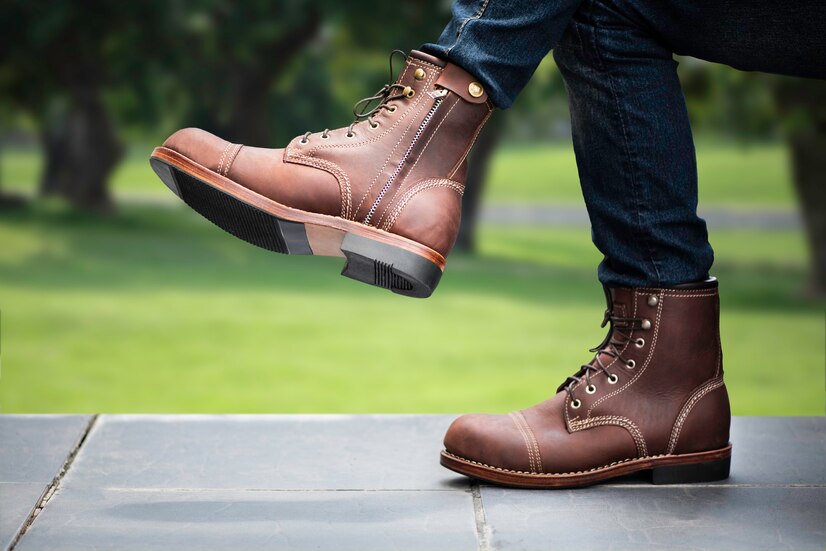When safeguarding your feet during demanding work, having a sturdy pair of work boots is crucial. Yet, merely owning top-quality boots is just the first step. To truly ensure the durability and functionality of your work boots, you need to take proactive measures to shield them from one of their most formidable adversaries: water.
In this blog post, we’ll dive into the ultimate work boot waterproofing tips to help you keep your feet dry, comfortable, and secure while on the job.
Why is Waterproofing Your Work Boots Essential?
Whether you’re looking for the best rain boots or prefer a classical logger fit, waterproofing them is essential. Here’s why:
Prolonged Lifespan
Waterproofing your work boots can significantly extend their lifespan. Continuous exposure to water can weaken the materials and stitching of your shoes, leading to premature wear and tear. By keeping your boots dry, you can maximize their durability and longevity.
Enhanced Comfort
There’s nothing worse than having wet feet on the job. It can result in blisters, cold feet, and, in extreme cases, even trench foot. Waterproofing your boots helps maintain a dry and comfortable interior, allowing you to focus on your work instead of discomfort.
Heightened Safety
Wet boots can reduce traction and stability, increasing the risk of slips, trips, and falls in the workplace. Proper waterproofing can help maintain the grip of your boots, enhancing your safety while working in challenging conditions.
Improved Health
Prolonged exposure to moisture can lead to various foot problems, including fungal infections and skin irritations. But not with waterproofed boots! They reduce the risk of these health issues.
Now that we’ve established the importance of waterproofing your work boots let’s delve into the ultimate tips to safeguard your investment!
1. Select the Right Work Boot Material
The first step in waterproofing your work boots starts with your chosen material. Different materials offer varying levels of water resistance. Here are some common work boot materials and their water-resistant characteristics:
- Full-Grain Leather: Full-grain leather is naturally water-resistant and can endure moderate exposure to moisture. However, it still requires proper waterproofing to maintain its integrity over time.
- Nubuck Leather: Nubuck leather is softer and more porous than full-grain leather, making it more susceptible to water damage. It necessitates thorough waterproofing and maintenance.
- Synthetic Materials: Many work boots are crafted from synthetic materials with good water resistance. Nevertheless, they may require more frequent waterproofing to sustain their effectiveness.
- Gore-Tex: Some work boots feature Gore-Tex membranes, which provide excellent waterproofing and breathability. Boots with Gore-Tex technology are often the top choice for wet conditions.
2. Regularly Clean Your Boots
Proper maintenance is essential for keeping your work boots waterproof. Regularly clean your shoes to eliminate dirt, mud, and other contaminants that compromise water resistance. Follow these steps:
- Remove the laces: Take out the laces to access all areas of your boots.
- Brush off dirt and debris: Utilize a soft brush or cloth to eliminate surface dirt and dust.
- Wash the boots: Use mild soap and warm water to cleanse your boots. A soft cloth is great for gently scrubbing a boot, paying extra attention to seams and crevices.
- Rinse and dry: Rinse the boots thoroughly to remove any soap residue. Room temperature is ideal for air drying. Also, keep them away from heat sources to avoid cracking the leather.
3. Apply Waterproofing Products
You’ll need to apply waterproofing products to transform your work boots into truly waterproof gear. Various options are available, each tailored to different boot materials. Here are some everyday waterproofing products and how to use them:
- Waterproofing Wax: Ideal for full-grain leather boots, waterproofing wax provides a protective layer that repels water. To apply, clean your boots as mentioned earlier, then rub the wax onto the leather using a clean cloth. You should dry it out before softly buffing it with a brush.
- Spray-On Waterproofers: These are suitable for various materials, including leather and synthetics. Spray the product evenly onto your clean, dry boots, and let it dry thoroughly.
- Silicone-Based Waterproofers: Silicone-based products create a waterproof barrier suitable for leather and synthetic boots.
- Nikwax: Nikwax is a famous brand that offers various waterproofing products, including wash-in treatments for Gore-Tex boots. Follow the product-specific instructions for best results.
It’s crucial to select a waterproofing product that matches your boot material and follow the manufacturer’s instructions carefully. Regular reapplication may be necessary, depending on your work conditions and the product used.
4. Invest in Quality Boot Liners and Insoles
In addition to treating the exterior of your work boots, consider investing in quality boot liners and insoles. These could add a layer of comfort and moisture defense. Here’s how they can help:
- Boot Liners: Insulated boot liners can keep your feet warm and dry by wicking away moisture and providing insulation. Look for liners made from moisture-wicking materials like Merino wool or synthetic blends.
- Insoles: High-quality insoles with moisture-wicking properties can help keep your feet dry from the inside out. Replace insoles regularly to maintain their effectiveness.
5. Seam Sealing
Seams are one of the most vulnerable areas for water penetration in your work boots. These are the points where different pieces of material are stitched together. Seam sealing involves applying a waterproof sealant along these seams to prevent water from seeping in. Here’s how you can do it:
- Ensure your boots are clean and dry.
- Use a specialized seam sealer or waterproof adhesive designed for footwear.
- Apply the sealant evenly along the seams, paying extra attention to high-stress areas.
- Allow it to dry thoroughly before wearing your boots again.
6. Avoid Overexposure
While waterproofing is essential, it’s equally important not to unnecessarily overexpose your boots to harsh elements. Prolonged exposure to water, mud, or extreme conditions can eventually wear down even the best waterproofing treatments. When not at work, store your boots away from direct sunlight or extreme temperatures.
Related: Starting A New Shoe Business: Here Are 5 Areas You Need To Concentrate On
7. Regular Inspection
Frequent inspection of your work boots is vital to ensure they remain in good condition. Here’s what to look for:
- Look for any evidence of wear, damage, or come-apart seams.
- Inspect the condition of the waterproofing treatment on your boots.
- Make sure your laces are in good shape and functioning correctly.
8. Repair and Resole as Needed
As your work boots age, they may need repairs or resoling. Cracks, holes, or worn-out soles can significantly reduce the effectiveness of your waterproofing efforts. Consider sending your shoes to a professional cobbler for repair and resoling if your shoes show significant wear. It’s an investment in the longevity of your boots.
Wrapping Up
By implementing these advanced tips and techniques, you can further fortify your work boots against water infiltration and ensure they serve you well for many seasons. Your feet will thank you for the dry and comfortable protection, and you’ll be well-prepared to tackle any job, no matter how challenging the conditions may be.
Good luck!
Read Also:






















